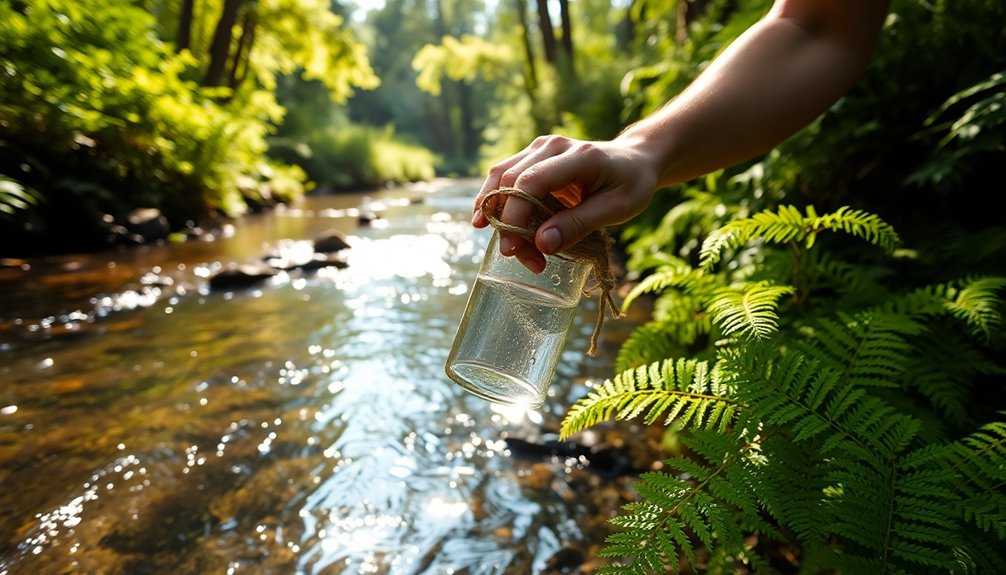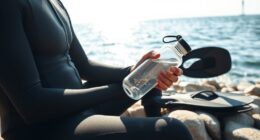Mastering water survival skills is essential for staying hydrated and safe. Start by learning effective techniques for floating and treading, which conserve energy and help you stay afloat when needed. Always assess water hazards before entering and use safe entry methods, like feet-first entry. Staying hydrated is important—aim to drink at least 2.5 liters of water daily, even when you're not thirsty. In emergencies, know how to access emergency water sources, like your water heater or natural streams. The more you know about these fundamental skills, the better prepared you'll be for any aquatic situation. Your journey to safety doesn't end here.
Key Takeaways
- Hydration is critical for survival; aim for at least 2.5 liters of water daily, increasing to 7.5 liters in emergencies.
- Store commercially bottled water, with at least one gallon per person per day, for emergency preparedness.
- Utilize water heater tanks and fill bathtubs or sinks before disasters to create an emergency water reserve.
- Treat natural water sources like streams or lakes before consumption to ensure safety.
- Keep track of individual hydration needs, which vary based on age, sex, body size, and activity level.
Importance of Water Survival Skills

Water survival skills are essential not just for personal safety but also for fostering confidence and independence in aquatic environments. Did you know that drowning is the leading cause of accidental death for children ages 1 to 4? By learning survival swimming skills, you can greatly reduce this risk. In fact, formal swimming lessons can cut drowning risk in children by up to 88%.
When you develop these skills, you not only enhance your safety but also boost your confidence. Maneuvering water confidently allows you to enjoy recreational activities without fear. You'll find that mastering self-rescue techniques helps you stay calm in emergencies, making your time in the water much more enjoyable. Moreover, proper training and safety precautions are critical layers of protection against water dangers.
Additionally, understanding practical water safety skills is invaluable. You'll learn how to swim to safety, escape entanglements, and navigate hazards like rip currents. This knowledge not only protects you but also instills a sense of independence in the water. Remember, every child who learns to swim can potentially save themselves from drowning, and that confidence can translate to other areas of life. Embrace these essential skills, and enjoy the freedom that comes with being water-safe.
Techniques for Floating and Treading

When you're in the water, mastering floating and treading techniques can be essential for your survival. Floating helps you conserve energy and stay calm, while effective treading water techniques keep you afloat with minimal effort. By focusing on these strategies, you can enhance your chances of staying safe in challenging situations. In addition to these techniques, knowing how to use a Personal Flotation Device can significantly improve your chances of survival.
Benefits of Floating
Floating is an essential skill that can greatly enhance your chances of survival in water. By mastering floating techniques, you'll conserve energy, maintain airway clearance, and improve your overall buoyancy, all of which are vital for prolonged survival. Here's a breakdown of the benefits:
| Benefit | Description |
|---|---|
| Conserves Energy | Uses minimal energy, especially in survival floats. |
| Maintains Airway Clearance | Keeps your face out of the water, preventing water intake. |
| Improves Stability | Spreads arms and legs to increase stability in water. |
| Enhances Survival | Effective in both calm and rough conditions. |
| Reduces Heat Loss | Keeps the body in a protective position against cold. |
These advantages allow you to relax and recover while floating, reducing the risk of exhaustion. In situations where rescue may be delayed, floating can also mean the difference between life and death. So, remember, by using your clothing to trap air and positioning your body effectively, you can enhance your buoyancy and improve your chances of surviving in challenging water conditions. Survival floating techniques are taught by organizations like the U.S. Navy and Boy Scouts, emphasizing their importance in emergency situations.
Treading Water Techniques
Mastering floating techniques sets the foundation for effective treading water skills, which are essential for staying afloat in various conditions. To begin, maintain a vertical position in the water with your head above the surface. Keep your spine straight and torso motionless, avoiding a horizontal stance that can lead to water splashing into your face. Tilt your head back slightly to minimize this risk. A vertical body position is crucial for maintaining stability while treading water.
For arm movements, use sculling techniques by moving your arms in a horizontal plane. Push water away with stiff hands and loose arms, employing a figure-of-eight or back-and-forth motion. Keep your elbows slightly bent and your wrists strong to enhance your sculling efficiency.
When it comes to leg movements, try various kicking techniques like flutter kicks and the egg-beater kick, where you alternate your legs in circular motions. This kick is particularly effective for maintaining buoyancy.
Practice treading water using a swimming noodle for support until you feel confident to do it unassisted. Focus on relaxed breathing and keep your limbs moving to stay afloat effectively. Combining these arm and leg movements will help you tread water efficiently.
Energy Conservation Strategies
Conserving energy while floating and treading water is essential for maintaining endurance and comfort in aquatic environments. To effectively manage your energy, focus on techniques that maximize buoyancy and minimize effort. Here are some energy conservation strategies you can apply:
| Technique | Description |
|---|---|
| Floating | Lie back in the water, spreading your arms and legs to distribute your weight. This position helps you stay afloat with minimal effort. |
| Treading with a kick | Use a gentle flutter kick, alternating with a scissor kick to keep your legs afloat while conserving energy. This reduces fatigue compared to vigorous kicking. |
| Arm positioning | Keep your arms relaxed at your sides or gently sculling to maintain balance without exerting too much energy. |
Maintaining clean water is crucial for overall health and energy efficiency, even when practicing water survival skills.
Safe Entry and Exit Methods
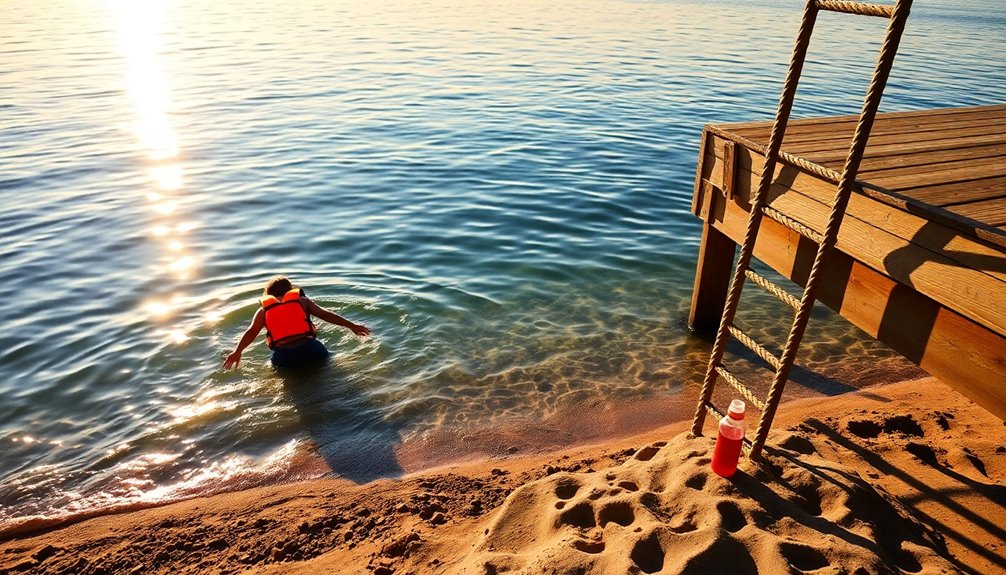
When entering or exiting water, you need to use safe techniques to avoid injury. Always assess the water depth first to guarantee it's safe before getting in or out. Having a proper exit strategy can make all the difference in staying secure and avoiding accidents. Additionally, ensure you stay hydrated during any water activities, as fluid needs vary based on the intensity and duration of your time in the water.
Safe Entry Techniques
Safe entry techniques are essential for anyone looking to enjoy water activities safely. When entering water, always start with a feet-first entry. This method lets you feel for the bottom and spot unexpected objects, reducing your chances of injury in unknown waters. It also helps you maintain control and balance as you lower yourself in.
If you're at a pool, consider the slide-in entry. This technique allows for a smooth, controlled entry, minimizing the impact when you hit the water. It's suitable for all ages and skill levels, making it a great choice to build your confidence. Supervision is key for ensuring safety during this process.
For younger or less confident swimmers, the step-in entry is ideal. This method guarantees a gradual approach, developing balance and stability while keeping safety at the forefront.
As you become more experienced, you can try jump and dive entries. Compact jumps or stride entries from the edge of the pool are effective ways to enter from deeper water. Remember to practice swivel and straddle entries as part of advanced techniques. Mastering these safe entry techniques will enhance your enjoyment and safety in all water activities.
Assessing Water Depth
Regularly evaluating water depth is essential for ensuring safe entry and exit methods during water activities. Utilizing tools like drone images and satellite imagery can greatly enhance your ability to assess depth accurately. When using drones, remember that high-resolution images taken at noon, without shadows, yield the best results. Adding polarizing filters helps minimize reflected light, further improving accuracy.
If you're near coastal areas, consider leveraging Sentinel-2 satellite imagery. This imagery, combined with advanced machine learning methods like Random Forest and Deep Neural Networks, can estimate water depth effectively, achieving impressive accuracy metrics. Morphological features can be generated to enhance your depth assessments. Notably, using data from ALOS-3's coastal band can significantly improve the accuracy of coastal depth assessments.
You can also use multispectral scanners that collect data across various bands. By employing the Beer–Lambert Law, you can derive bathymetry models to estimate depth. Analyzing different bands helps refine your estimates further.
Proper Exit Strategies
As you prepare for water activities, knowing proper exit strategies is vital for your safety. Start by using safe entry techniques like the step entry, compact jump, or feet-first entry. These methods help you maintain control and minimize risks as you enter the water.
When it's time to exit, use the edge of the pool or shore for support. Confirm you have a secure handhold and foothold to prevent slipping. If you're tired, you can float to a standing position or scull your way to the exit, keeping your body upright. Removing heavy clothing in deep water can also make it easier to float and exit safely. Furthermore, having adult supervision present can significantly enhance safety during water activities.
In specialized situations, practice clothed exits or simulate emergencies by swimming underwater before surfacing. Always be aware of your body orientation and signal for help if needed. If you're in a group, reassure others to maintain calmness. Finally, wearing a Personal Flotation Device (PFD) can greatly assist your safety while swimming. Mastering these exit strategies not only enhances your confidence but also guarantees you're prepared for any unexpected incidents in the water.
Mastering Breathing Techniques

How can mastering breathing techniques enhance your water survival skills? By learning to manage your breath effectively, you can conserve energy and increase your chances of staying afloat. Floating is a low-energy method that allows your body to rest while keeping you above water. Tuck your knees against your chest, make gentle swimming motions with your arms to lift your head above water, and breathe in and out calmly before returning to your resting position.
Treading water is another essential skill. It helps you stay afloat and maintain a normal breathing pattern while using minimal energy. Practice this technique for at least one minute to build endurance. Additionally, rolling over from front to back enables you to catch your breath and rest when fatigue sets in—just lie back, kick your feet slightly, and gently move your arms. Learning these skills builds a strong baseline of survival skills that enhances your overall safety in the water.
In emergencies, consider using clothing as a flotation device. Fill it with air and tie off the ends, creating a buoyant tool to support your breathing. Mastering these breathing techniques not only keeps you calm but also enhances your overall water survival capabilities.
Swimming to Safety
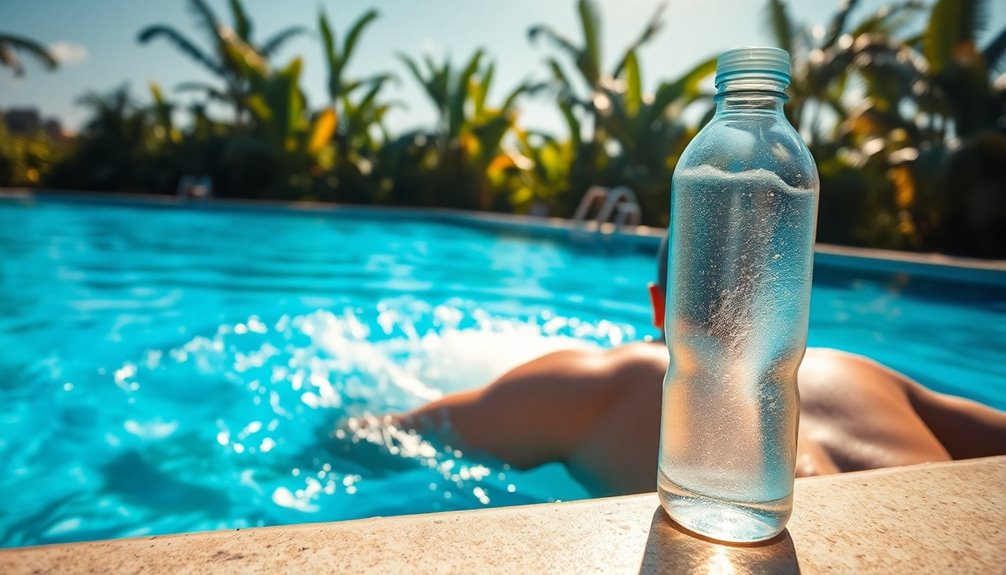
When you're in a water emergency, knowing how to swim to safety can be a lifesaver. First, understand your limitations. It's crucial to respect water boundaries, like swimming only between red and yellow flags at the beach. Always swim under adult supervision and avoid entering deep water if you're not confident in your skills.
When entering the water, use a safe method. Lower yourself in feet-first to check for depth and obstacles. If you need to jump, the stride jump can help you assess the situation better. Once in the water, practice staying afloat. Treading water for at least a minute builds confidence, while floating on your back helps you breathe and signal for help. Additionally, knowing that approximately 800 children drown annually underscores the importance of these skills.
If you need to move, employ survival strokes like sidestroke or backstroke to conserve energy. You can also use the swim-float-swim method for self-rescue. If you find yourself in distress, signal for help by raising an arm and shouting. Always prioritize safety by using flotation devices for rescue rather than jumping in. By mastering these skills, you'll enhance your chances of reaching safety.
Essential Safety Rules

To guarantee a safe experience in and around water, it's vital to follow essential safety rules that protect you and those around you. Always supervise children closely when they're near water, and eliminate hazards in pool areas. Implement layers of protection, like fencing with at least four sides, to restrict access to pools and spas. Be a vigilant "water watcher," putting away distractions like cell phones to maintain focus.
Master safe entry and exit techniques. Learn to enter the water feet-first and climb out using your elbows and knees. Practice these moves to verify you can handle various scenarios, including entering deep water and resurfacing. Consistent education on water safety can significantly reduce drowning incidents.
Know your limits and always swim with a buddy. Recognize your physical capabilities and avoid swimming in challenging areas. Stick to designated swimming zones, and never swim alone—preferably with lifeguards or designated watchers.
Lastly, prepare for different water environments. Be aware of specific dangers, like strong currents or temperature fluctuations. Always check weather conditions before heading out. Remember, if you find yourself in trouble, raise an arm and shout for help to signal for assistance.
Emergency Flotation Techniques
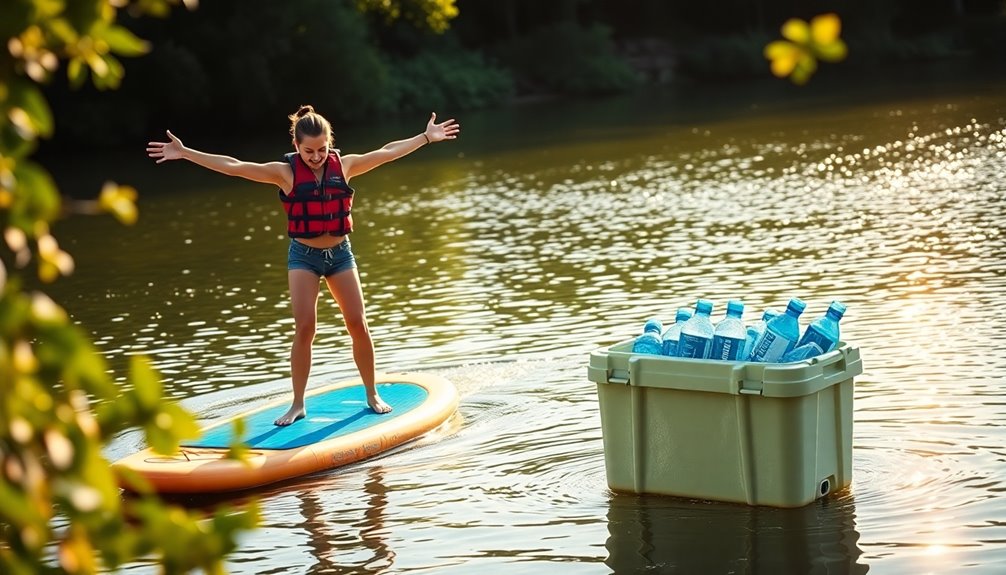
In an emergency situation, knowing effective flotation techniques can be a lifesaver. Start by using your clothing as a flotation device. Remove pants or shirts, fill them with air, and tie off the ends to keep the air in. Raise the filled clothing above your head to scoop in more air, then use it to stay afloat.
You can also use the horizontal back float technique. Lie back, stretch your arms out, and arch your back slightly to let your legs rise. Keep your face above water and relax to conserve energy. Alternatively, try the vertical back float: tilt your head back and press down with your arms and legs to keep your mouth above water. Hold your breath, then exhale while preparing to break the surface. Relaxation aids in calming the body and controlling breath during these techniques, which is crucial for effective flotation.
If you have a personal flotation device (PFD), wear it correctly to float effortlessly. In cold water, keep your clothes on to trap air and provide warmth. For group flotation, huddle together, facing each other, using PFDs for support. These techniques can greatly improve your chances of survival when unexpected situations arise.
Recognizing Water Hazards

Recognizing water hazards is essential for your safety while swimming or engaging in water activities. Hidden debris like rocks, logs, and uneven surfaces can cause serious injuries. Make sure to be cautious of weeds and plants that can entangle you underwater, especially in murky conditions where visibility is limited. Remember, underwater currents can be strong and unpredictable, adding to the potential dangers.
Be aware of water conditions and depth, as open water typically lacks depth markings. Sudden drop-offs can occur just a few steps from the shore, and waterways are often deeper than they appear. Cold water temperatures can impact your swimming ability and lead to Cold Water Shock, so always assess the environment before entering. Additionally, the occurrence of hydrological hazards can vary greatly depending on environmental conditions, so it's important to stay informed.
Additionally, currents, tides, and wave actions can change rapidly. Fast-moving currents in rivers and streams pose risks, as do waves and rip currents in oceans and lakes. Be vigilant about weather conditions, since heavy rains can alter water safety drastically—especially in man-made channels. Finally, consider the remoteness of some locations, as this may delay rescue attempts if you encounter trouble. Always stay alert to these hazards to protect yourself.
Staying Hydrated in Emergencies

Staying hydrated is essential in emergencies, as your body needs water to function properly. You'll need to know where to find reliable water sources, whether it's from flowing streams or collected rainwater. Understanding the importance of hydration and how to access water can make all the difference in a survival situation. In extreme conditions, maintaining hydration is crucial for physical performance and overall survival.
Importance of Hydration
Hydration is a lifeline during emergencies, as the human body relies heavily on water to function properly. Comprising about 60% water, your body needs this essential resource for temperature regulation, joint lubrication, and maintaining blood volume. When you're dehydrated, even mild symptoms like thirst and dry mouth can escalate into fatigue, weakness, and confusion. These impairments can seriously affect your cognitive function, making it harder to think clearly and make decisions in critical situations.
In emergencies, the risk of dehydration increases due to high temperatures, physical activity, or limited access to water. The World Health Organization recommends at least 2.5 liters of water daily for adults, but during emergencies, aim for a minimum of 7.5 liters per person per day. This guarantees you stay hydrated while also covering basic hygiene needs. Individual water needs vary based on factors such as age, sex, body size, and activity level, so it's crucial to assess your own requirements.
To maintain hydration, drink regularly, even if you don't feel thirsty. Increase your fluid intake before, during, and after any physical activity. Remember, protecting your water sources and confirming it's safe to drink is essential. Staying hydrated is not just about survival; it's about keeping your body and mind functioning effectively in challenging situations.
Emergency Water Sources
In emergencies, knowing where to find water can make all the difference. Your safest bet is commercially available bottled water. Aim to store at least one gallon per person per day for three days, and don't forget to check expiration dates and rotate your supply every six months, especially in hot conditions. It's essential to incorporate an Emergency Drinking Water Supply (EDWS) plan to ensure you have a reliable source of safe drinking water during emergencies.
If you're at home, tap into your water heater tank—just verify the power or gas is off and the intake valve is closed. Canned fruit or vegetable liquids and melted ice cubes from clean water can also provide hydration. Toilet tank water is usable if it's free from cleaning chemicals, and you can access trapped water in plumbing by breaking the vacuum seal.
Before disaster strikes, fill bathtubs or sinks to create an emergency reservoir. Rainwater can also be collected but requires treatment before drinking. If you consider natural sources like streams or lakes, always treat the water first, avoiding any that looks or smells odd.
For storage, use FDA-approved containers, sanitize them, and keep them cool. Remember, replace stored water every six months and label the containers with dates.
Resources for Further Learning
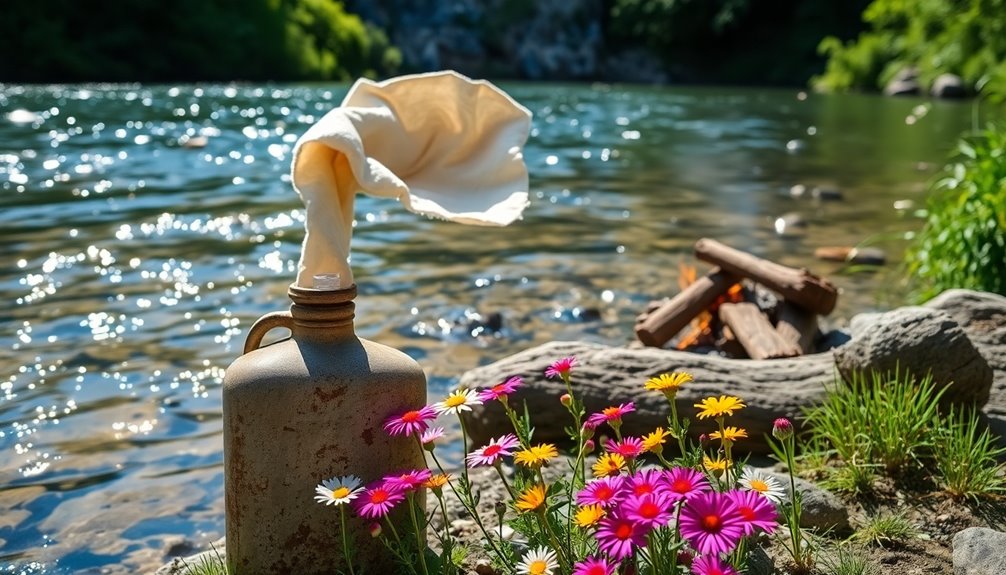
Exploring resources for further learning about water survival skills can greatly enhance your safety and confidence in aquatic environments. Start by enrolling in classes led by certified instructors who have experience with children and adults alike. Structured curriculums help you build essential skills progressively, from floating to swimming to safety.
Participate in community classes that cover crucial topics like safe entry and exit techniques, treading water, and emergency response. Don't forget to include family members in your learning journey—practicing together reinforces skills and promotes a culture of safety. Additionally, learning emergency rescue techniques can prepare you to assist others in distress.
Online resources are also invaluable. Websites like the American Red Cross offer thorough guides and videos on water safety practices. These can serve as excellent supplementary tools for your learning.
Always remember to swim with supervision, choose safe locations, and avoid swimming when tired. Familiarize yourself with emergency procedures, such as creating flotation devices from clothing and learning rescue techniques. By utilizing these resources and committing to ongoing education, you'll be well-prepared for any situation that arises in the water. Stay informed, stay safe, and enjoy your aquatic adventures!
Frequently Asked Questions
What Are the Signs of Dehydration While Swimming?
While swimming, you should watch for signs of dehydration. If you notice dark yellow urine, dizziness, or a dry mouth, it's time to pay attention. You might feel fatigued or experience muscle cramps. If you start feeling confused, extremely thirsty, or notice rapid breathing, those could be severe symptoms. Staying aware of these indicators can help you avoid serious health issues while enjoying your time in the water.
How Can I Stay Calm in Emergency Water Situations?
In emergency water situations, staying calm's essential. Center yourself with controlled breathing and focus on the immediate environment. Assess your surroundings for safety, securing stability before acting. Prioritize communication, signaling for help if needed. Don't panic; think through your options clearly. Maintaining a positive mindset can transform turmoil into tranquility. Remember, your awareness and adaptability can make a difference. Embrace the moment, and you'll navigate the challenge with composure and confidence.
What Should I Do if Someone Else Is Struggling in Water?
If someone's struggling in water, stay calm and assess the situation first. Guarantee your own safety before attempting a rescue. If you can, reach out with a pole, rope, or flotation device. Avoid jumping in unless you're trained, as it can worsen the situation. Call for help if possible. Encourage the person to float on their back and conserve energy until assistance arrives. Always prioritize safety for both of you.
How Often Should I Practice Water Survival Skills?
You should practice water survival skills consistently to build confidence and competence. Aim for 5-10 minute sessions at the start of each playtime, repeating key skills 6-8 times, especially for younger swimmers. For older kids, maintain regular practice under supervision. Mix different skills during each session to guarantee a well-rounded understanding. Remember, practice not only reinforces learning but also helps retain these essential skills long-term, reducing risks associated with water activities.
Are There Specific Age Considerations for Water Survival Training?
Yes, there are specific age considerations for water survival training. For infants and toddlers aged 3 months to 3 years, focus on floating and safe entry techniques. For children aged 4 to 14, skills like treading water and exiting without a ladder are essential. Teens and adults, 15 years and older, refine their skills and learn emergency preparedness. Tailoring training to each age group guarantees effective learning and safety in water environments.
Conclusion
In the dance of survival, mastering water skills transforms you into a graceful partner with the elements. By honing your techniques and staying vigilant, you can navigate the aquatic domain with confidence. Remember, hydration's your lifeline, and awareness your compass. Embrace these essentials, and you'll not only weather the storm but also emerge stronger, like a phoenix rising from the depths. Equip yourself with knowledge, and the water's embrace will become less a struggle and more a symphony of safety.

